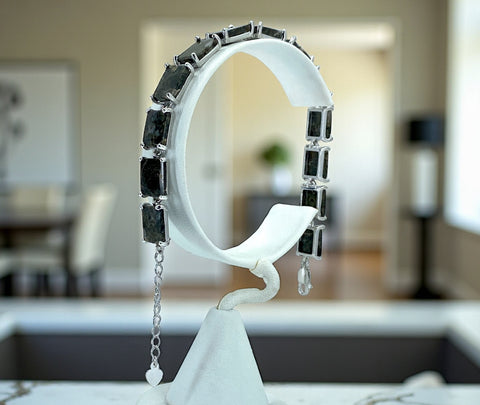Le Visitatrici Lunar Bracelet - Genuine Lunar Meteorite Jewelry
Le Visitatrici is a unique expression of another world visiting ours. 13 hand carved lunar meteorites adorn this one-of-a-kind masterpiece designed and crafted by Joshua Eisler. The meteorites are set in a stunning .925 silver to reflect the silver brilliance of the Moon. The light of the setting elegantly complements and sets off the deep color and patterns of the Visitatrici meteorites. The name Visitatrici is Italian for "visitors" and is so named in homage of the Italian astronomer Giovanni Domenico Cassini who created the first scientific map of the Moon.
Bracelet length (Adjustable): 170mm - 196mm
Number of set Lunar Meteorites: 13 hand cut lunar meteorite stones
Dimensions of each set Lunar Meteorite: 10.40mm x 8mm
Setting: .925 Silver
Paren body: The Moon - this is material formed on the Moon and ejected from our celestial neighbor by a meteorite impact and then itself became a meteorite when it hit the Earth. It was recovered in 2021 in the Sahara Desert.
Lunar meteorite official name: NWA 16530
Type: Lunar fragmental breccia
Year Found: 2021
Country: Northwest Africa
Description: The enchanting Le Visitatrici lunar bracelet has been hand crafted from a single lunar meteorite into 13 free-hand shaped pieces to find and enhance the best qualities in each area of the stone, making each of the 13 pieces of meteorite one-of-a-kind and masterfully unlike anything else on this planet. These lunar center stones have been set in .925 sterling silver to make this unique and delightful bracelet.
| Northwest Africa 16530 | |||||||||||||||||||||||||||
|---|---|---|---|---|---|---|---|---|---|---|---|---|---|---|---|---|---|---|---|---|---|---|---|---|---|---|---|
| Basic information |
Name: Northwest Africa 16530 This is an OFFICIAL meteorite name. Abbreviation: NWA 16530 Observed fall: No Year found: 2024 Country: Morocco Mass: 840 g |
||||||||||||||||||||||||||
| Classification history: |
This is 1 of 48 approved meteorites classified as Lunar (frag. breccia). |
||||||||||||||||||||||||||
| Comments: | Approved 8 Apr 2024 | ||||||||||||||||||||||||||
| Writeup |
Writeup from MB 113:
Northwest Africa 16530 (NWA 16530) Morocco Purchased: 2024 Jan Classification: Lunar meteorite (frag. breccia) Physical characteristics: Many small stones between approximately 1 and 20 g without fusion crust, some with caliche covering part of their exterior. Saw cut reveals a dark-gray interior with light angular and rounded clasts. Petrography: (D. Dickens, CCMS) Examination of a polished microprobe mount shows a polymict fragmental breccia of mostly anorthite with accessory olivine and pyroxene. Fine-grained matrix contains vesicles from <1 µm to approximately 100 µm. A few Fe-Ni grains were observed. Geochemistry: (D. Dickens, CCMS) Olivine Fa24.6±1.4, Fe/Mn=100±15, n=5; Pigeonite Fs22.7±1.1Wo10.9±1.9, Fe/Mn=56±7, n=4; Plagioclase An97.2±0.1Ab2.18±0.1, n=7. Classification: Lunar fragmental breccia Likely paired with Bechar 003, 007, 009, 010, 010, and 012. Specimens: 20.6 g at TCU; remainder with J. Eisler |
||||||||||||||||||||||||||
| Data from: MB113 Table 0 Line 0: |
|
||||||||||||||||||||||||||
| Institutions and collections |
TCU: Oscar E. Monnig Collection, Department of Geology, Texas Christian University, Ft. Worth, TX 76129, United States; Website (institutional address; updated 2012-02-24) CCMS: Colorado Center for Meteoritic Studies 6200 Becker LN Loveland, CO 80538, United States (private address; updated 2024-01-22) |
||||||||||||||||||||||||||
| Catalogs: |
|
||||||||||||||||||||||||||
| References: | Published in Gattacceca J., McCubbin F. M., Grossman J. N., Schrader D. L., Cartier C., Consolmagno G., Goodrich C., Greshake A., Gross J., Joy K. H., Miao B. and Zhang B. (2025) The Meteoritical Bulletin, No. 113. Meteoritics & Planetary Science.
|
||||||||||||||||||||||||||
|
Geography: |
Statistics: This is 1 of 2398 approved meteorites from >Morocco (plus 36 unapproved names) (plus 1 impact crater) |
||||||||||||||||||||||||||
We Also Recommend














